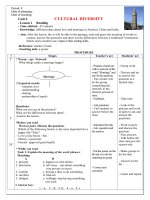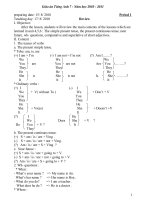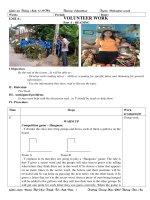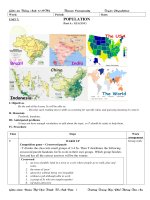Gián án Unit 2 Tieng Anh 12 chuan
Bạn đang xem bản rút gọn của tài liệu. Xem và tải ngay bản đầy đủ của tài liệu tại đây (1.12 MB, 12 trang )
Week: Period: Date:
Unit 2: cultural diversity
Part A: Reading
I. Objectives:
1. Educational aim:
- Students read passage comprehension about role of cultural diversity
- Students know how to use the new words through asking and answering
2. Knowledge:
- General knowledge: - Through this unit, students know more about cultural diversity
- New words: Words related to the topic( culture, society....)
3. Skills: -Guessing meaning from context
-Summarizing main idea
-Passage comprehension
II. Method: Intergrated, mainly communicative
III. Teaching aids: Board, tape, cassetteplayer, chalks, textbook and notebook
IV. Procedures:
Teacher’s activities Students’ activities
Warm-up: (4 minutes)
- Ask students to list out the factors that create a happy life
-Let students work in pairs
-Ask students questions
_Lead in: Today, we’ll study a new lesson Unit 2- part A
:Reading
Pre-reading: (7 minutes)
- Ask students to work in groups of four
- Listen to the teacher
- Answer the question
-Work in groups to talk about the
and guess what are happening in the picture.
-Hang on the blackboard the table of the questions to help
students to guess the activity in each picture:
- Which of the following factors is the most important for a
happy life ?W hy ?
- Love, money, parents’ approval, a nice house,a good job,
good health...etc.
- Ask the representatives of the groups to express their
ideas in front of the class.
- Give the feedback
+ Pre-teach some new words
- precede (v) - counterpart(n)
- confide(v) - sacrifice (v)
- Ask students to read up in chorus twice.
- Ask students to guess the meaning of the new words.
+ Introduce the situation of the passage
+ Show students the tasks of the reading
While-reading: (20 minutes)
- Make the class read the small talks, to scan the details and
do the tasks
Task 1 :
Ask students to read the passage in skim to make sure the
meaning of the words.
- Call some students to show the meanings
- Ask students to read the passage again and do the task in
groups of four
- Call on some students to read the answers in front of the
class.
- Ask students to read the sentences with the words given
Task 2
- Ask students to work in pairs to answer the questions
given.
- Call on some students to show the class the right answers
-Listen to the students and help them if neccesary.
activities in the pictures
- Look at the questions and try to
answer them in groups to discuss.
- One student speaks out his/her ideas
in front of the class .
- Look at the board, note down.
- Read the new words in chorus twice.
- Work in groups to guess meanings of
the words.
- Listen to the teacher
Read the passage in skim
- Show the meaning of the words.
- Work in groups to fill in the blanks.
- Read the italicized words/ phrases
and explain in front of the class :
1, precede : happen or exist
2, determine : find out
3,confide : tell somebody about
something very private or secret
4,sacrifice : willingly stop having
something you want
5, obliged : having a duty to
something.
- Work in pairs to answer the
questions.
A: What are the four key values in
the survey ?
B: They are Physical attractiveness,
Confiding,........
A: Who are much more concerned
with physical........... ?
B :The young Americans are much
more concerned than the young
Indians and the Chinese........
A: What are the Indian students’
Post-reading: (12 minutes)
-Ask students to work in groups to discuss about the
question :
+ What are the differences between a traditional
Vietnamese family and a morden Vietnamese family ?
- Give some suggested words to talk about a
family :number of children, the house they like to have, the
head of the family , who works , who takes care of the
housework and children , the income...
-Call on some representatives on the groups to talk about
the differences
Homework : (2 minutes)
-Do reading text in workbook
-Prepare the next lesson
attitudes on a partnership of equals ?
B :The Indian students agree that a
woman has to sacrifice........
- Read the questions carefully and
work in pairs to answer the questions.
A: - I think a modern family has fewer
children than a traditional one.
the head of the family in a modern
family is both a husband and wife,
they share the household chores and
take care of their children....
- Work in groups to discuss to compare
to other groups.
- Talk in front of the class about the
class.
-Listen to the teacher and take note
Week: Period: Date:
Unit 2: cultural diversity
Part B: Speaking
I. Objectives:
1. Educational aim: Students can talk about the differences among cultures
2. Knowledge:
- General knowledge: - Through this unit, students can talk about the differences among cultures
- Know how to arrange opinions sensibly
- Language: Students use sentences, words, phrases and expressions for making their view
3. Skills: Fluency in expressing opinion and expressions for making a opinion
II. Method: Integrated, mainly communicative
III. Teaching aids: Pictures, English textbook 12, hand-outs
IV. Procedures:
Teacher’s activities Students’ activities
Warm-up:(5minutes)
Checking the last lesson
- Call two students to go to the board.
Students 1 and 2 : Talk about the differences between a
traditional family and a modern family they’ve written at
home.
- Ask the other students to comment about the talking.
- Feedback and give correction if necessary
- Lead the whole class to the topic of the lesson.
Pre-reading: (8 minutes)
- Listen to the teacher
-Read the paragraph in front of the
class
- Task 1:
We are going to talk about the differences among
cultures .
- Ask students to express their point of view on the
followings ideas , using the words or expressions in the
box.
* In Vietnam ,three or even four generations may live in
home.
* A happy mariage should based on love.
* In some Asian countries , love is supposed to follow
marriage not precede it.
* In some countries, a man and a woman may hold hands
and kiss each other in public.
- Listen to the students and give remarks
While –speaking : (16munites)
Task 2:
- Ask students to work in pairs to discuss about the
differences between the culture in America and in
Vietnam.
+Give the culture in America:
- Two generations ( parents and children ) live in a home.
- Old- aged live in nursing home.
- It is not polite to ask questions about age, marriage and
income.
- Americans can greet anyone in the family first.
- Groceries are bought once a week.
- Christmas and New Year holidays are the most
important.
- Children sleep in their own bedrooms.
+ Listen to the students and give more the ideas about the
differences.
Post-reading: (14 minutes)
Task 3:
- Ask students to work in pairs or work in groups to talk
about the similarities and differences between
Vietnamese and American cultures, using the features
- Listen to the teacher
- Read the sentences given and work in
groups to dicuss.
A : In my opion,it is not good for three
or four generations to live in a family
because they will find it difficult to
sympathy their interests and habbits
...and I agree that love is supposed to
follow mariage not precede it.
B: I don’t agree with your ideas, I think
it is good to have three or four
generations living under one roof
because they can help each other a lot
- Work in pairs to discuss and give their
ideas about the differences
+ Give the culture in Vietnam.
-There are more generations in a home
(grand parents, parents and children ...)
- Elders live with their children and are
taken care of by their sons.
- Can ask the questions about the age,
marriage and income..
- Have to greet the older first.
- Do the shopping everyday.
- Tet holiday is the most important.
- Children can share bedrooms with the
other in a family.
-Work in groups or in pairs to compare.
Ps : - There are differences and
similarities between Vietnamese and
discussed in the task 2 .
- Listen and give remarks on their opinions
Homework:(2minutes)
-Students write a paragraph about the cultures in Vietnam.
- Do the exercises in the workbook
- Prepare for the next lesson
American cultures .In America, two
generations (parents and children) live
in ahome . In Vietnam, two, three
or even four generations live under one
roof...etc.
-Listen and copy
Week: Period: Date:
Unit 2: cultural diversity
Part C: Listening
I. Objectives:
1. Educational aim: Students should know how to listen to give some information about the wedding
ceremony in Vietnam.
2. Knowledge:
- General knowledge: Students learn about the wedding ceremony in Vietnam.
- Language:









